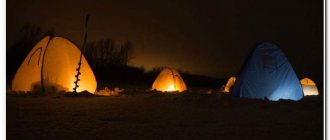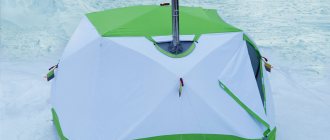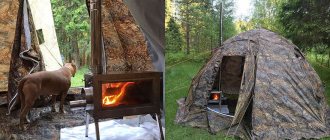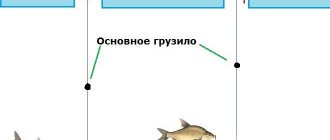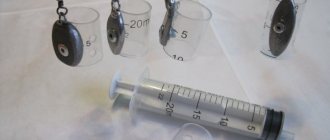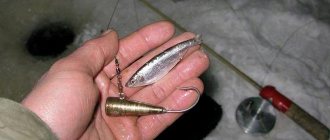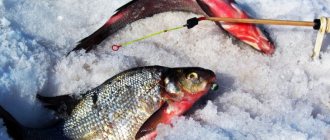Selection requirements
Today, a good tent for ice fishing is not an indicator of luxury, but a necessary attribute in the household. You need to approach its choice with all responsibility, evaluate your financial capabilities, but also not immediately run to the store at the sight of cheap advertising. There are special requirements for the selection of these products. First of all, they must protect the fisherman from wind and cold, so the material from which they are made is of great importance.
It should be dense, windproof and at the same time allow air to pass through well. Otherwise, moisture will accumulate on the inner walls and they will become icy. Tents are mainly made of synthetic materials and canvas. Synthetics, of course, are not for winter; canvas tents are most popular among winter fishing enthusiasts. Special windows also deserve attention - vents, with the help of which the space of the tent is ventilated without creating discomfort due to frosty air.
The pipe from the heating device also comes out through the window. In addition, the windows allow light to pass through, and during the daytime there is no need for artificial lighting. When choosing this or that model, you need to check the strength of the structure, otherwise it will not be able to withstand strong gusts of wind and will break. The quality of assembly and fastening of the product to the ice is also of great importance.
There are tent models that have a bottom; they retain heat much better and are designed for long periods of time on ice. The bottom can be unfastened while fishing. To create greater comfort for yourself, it is better to choose a two-layer or three-layer model. They have an additional awning and insulated internal walls
The color of the tent is also important. If it is white or yellow, the sun's rays penetrate well inside, and visibility will be much better
How to install a travel scarf
Today, outdoor enthusiasts usually use hemispherical frame tents, “half-barrels” and combined models. Modern designs are comfortable, functional and reliable.
How to set up a hemisphere tent
Hemispherical frame models are considered the most popular. These tents are quick to set up and hold up well in the wind.
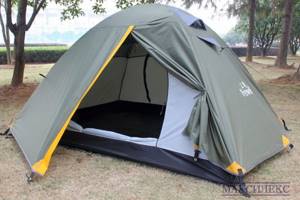
Photo No. 1: hemisphere tent
The installation process is as follows:
- Lay out the inside of the tent on the ground. Connect the parts of the semicircular arcs.
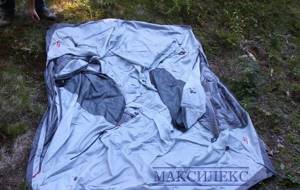
Photo No. 2: the inside of the tent
- Attach the assembled frame elements to the inside of the tent. Manufacturers equip models with various devices. The most convenient fasteners are hooks.
Photo #3: Setting up the inner tent
- The next stage is installation of the awning. Throw it over the tent, not forgetting to match the exits. Secure the cover to the ground with pegs. Stretch the awning and vestibule itself. If this is not done, condensation from breathing will accumulate and flow.

Photo No. 4: installation of the awning
- The tent is ready. Use the storm ropes placed on its sides if you are located in an open area and are afraid of strong winds. If the tent is in the forest or protected by other structures, additional reinforcement is not required.
Photo No. 5: installed hemisphere tent
Installation of half-barrel tents
They differ from hemispheres in shape and increased size and often have two entrances. The frame consists of several semicircular arcs.
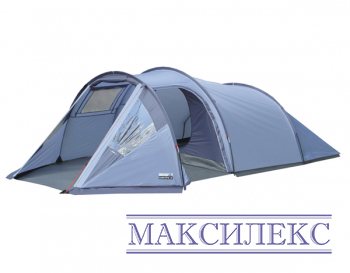
Photo No. 6: half-barrel tent
For installation:
- place the awning on the arches;
- fasten the inside of the tent from the inside;
- stretch the covering with pegs.
Features of fishing in winter
The most important feature of fish behavior in winter is loss of activity. This is due to a decrease in the amount of food in the reservoir. After the autumn meal, the fish becomes passive and tries to minimize energy consumption as much as possible.
Of course, all this cannot but affect the number of bites and the resistance of the fish itself when fished out of the water. But on the one hand, this is bad, since often you have to deliver the bait practically under the fish’s nose, but there is also a positive point here! Since the fish is less active and weaker, you can use a thinner line, which will be less noticeable in the water, which will be a big plus for the fisherman. You can also use lighter and more sensitive gear, which allows you to feel every blow of the fish when fishing.
Do not forget that if there is ice on the reservoir, almost all hot spots become accessible, which in the summer are quite difficult, and sometimes completely impossible, to get to without a boat.
But unfortunately, winter fishing has not only advantages, but also quite a number of disadvantages, which should also be mentioned, and when going fishing, I would advise you to weigh all the pros and cons, and then prepare well for it.
The main disadvantage is the cold. You should dress warmly, and considering that any body of water is an open space, then clothing should protect not only from the cold, but also from the piercing wind. To do this, you should buy yourself a special winter fishing suit, shoes, and if the stops are long enough, then it is advisable to buy yourself a special tent that will additionally protect the fisherman from the wind. Otherwise, you risk freezing and getting sick, and winter fishing itself will not bring you that unique pleasure.
The next disadvantage is drilling holes; to find fish in a pond you need to be patient and drill more than a dozen holes, especially if you do not have the necessary knowledge about the reservoir. I will also add that not only patience is required, but also physical strength, which will require a lot to drill holes, especially if the ice exceeds half a meter in thickness.
How to fold a tent?
Automatic tents (or automatic tents) consist of flexible, springy steel covered with polyester. Such tents have a great advantage - they are very quick and easy to set up. But problems arise with the reverse process, although folding such a tent is also easy. So, how to fold a tent? Stage 1: fold all sides of the tent into one, i.e. roll the tent flat. You should end up with one flat triangle, square or something similar. Stage 2: put the tent on the floor and pull one of the sides towards you, pressing it to the opposite edge of the plane. The steel arcs of the tent will begin to twist into a figure eight. Next, it remains to tighten the figure eight, turning it into 0 or a circle. Voila! :) This is a general principle, but there are also subtleties. For example, large automatic Chinese tents (for example, Quechua) need to be rolled up several times. Here's some good advice: fold your tent at home several times before taking it out into the wild. And for clarity, here’s a video of how to fold a tent-machine into a ring:
Choosing the best option
Of course, one of the most important characteristics here will be the material from which the winter fishing tent is made. Thanks to technological progress, the most popular synthetic materials here are:
- Nylon;
- Silk;
- Lavsan;
- Polyamide and others.
All these materials are quite strong and durable. It is better to immediately exclude classic canvas tents from candidates due to their heaviness and high hygroscopicity. The outer layer of modern ones is water-repellently impregnated with polyurethane or silicone.
We advise you to read: Fishing for bream in winter
In the passport for each tent you can find not only the composition of the fabric, but also:
- the brand of its weaving,
- moisture resistance indicator
- density.
In order not to depress the future owner with numbers, we only note that the higher they are, the better the resistance of a particular fabric to rain, wind and snow. Compare the labeling of two or three competitors to your choice, and the situation will become clearer by itself.
The choice of manufacturers in favor of synthetic fabrics is quite logical. For one of the main criteria for fishermen’s temporary housing is its weight. In the vast majority of cases, the tent will have to be carried from the vehicle to the reservoir and back in your hands or on your shoulders. We agree that in addition to the obligatory ice auger, backpack, container with tackle and bait, an additional 5, 10, or even more kilograms is more than a significant burden.
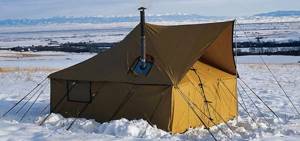
Installation and dismantling time is an important indicator
Another important indicator is the time for installation and dismantling. Few people come for fishing to catch fish and spend precious time building shelter from the wind and bad weather.
The speed record holders here are models from the “spring” and “umbrella” series. Where a few minutes are enough to open the tent, but their reliability leaves much to be desired. One way or another, it is impossible to ignore such an indicator as installation and dismantling time.
The reliability and stability of a tent is, first of all, determined by the quality of its frame. Aluminum and fiberglass will be a priority here over flimsy plastic or brittle metal profiles. In this aspect, you will also have to make a choice between weight and a guarantee of reliability.
Interesting article: Gerber ultimate knife (gerber knife) my review
Stability is important for a winter tent
The stability of fishermen's winter shelter largely depends on its shape. So a cube-shaped structure will have a much greater windage than a conical or hut-shaped one. Sloping walls and roof will not retain snow and melt water, so you will have to sacrifice free space.

Almost every brand of manufacturer of tents for winter fishing has samples of one-, two-, and three-person tents. Experience has shown that a fisherman will feel quite comfortable if he is allocated at least 2 square meters. meters of territory.
Typically, tents for one person have three beams (ribs), and structures with a larger capacity have four or more. It follows that a one-person tent will always be less stable against the wind.
Along with the advantages, tents for winter fishing also have disadvantages. They limit your visibility and freedom of movement, make you less mobile on the ice and, of course, increase the volume and weight of your arsenal. And yet, having a tent for winter fishing is convenient, comfortable and much safer than fishing outdoors.
However, you have to pay for such convenience. Modern high-quality models of shelters from cold and bad weather are not cheap. Therefore, it is worth assessing the degree of necessity of this purchase, then read our advice again and only then go shopping. Only then will she be a joy to you. And every ice fishing trip will be filled with positivity, and an ice fishing tent will help with this.
Read us in:
Advantages and disadvantages
Fishermen who have tested a cube tent for winter fishing are generally satisfied with their purchase and often recommend this particular form to their friends and acquaintances.
This is facilitated by the advantages of the product. Among others, we can highlight the following:
- sizes, they are very important in this case. Several fishermen can be in the tent at the same time, and they will not interfere with each other at all. In addition, no one will be able to sit on the box all the time; thanks to the normal height, every adult can stand up to their full height and stretch their stiff muscles.
- The ability to quickly set up a tent is no less important; in a matter of seconds you can set up the product and immediately start fishing.
- When folded, the tent takes up little space and weighs very little. These are important criteria for those who do not have their own vehicles and travel to fishing spots by public transport.
- After installation, you can drill holes without any problems, the ice chips will not freeze to the skirt, the material is treated with an anti-freeze compound.
- If necessary, the cube tent can be quickly folded and moved to another fishing spot.
But the product also has disadvantages, although their advantages are partially concealed:
- the high height of the internal space promotes the stratification of air masses; they do not mix. Heat collects in the upper part, but the lower part, where the fisherman is located, remains cool. Therefore, in severe frosts and at night, you cannot do without a heat exchanger.
- The material of the tent is not always strong enough; a light touch of the ice drill knives immediately leaves marks. But there is also an advantage here: the fabric does not fall apart, it can be repaired with ordinary glue.
- For some, the entrance from the side in the form of a hemisphere is not very convenient; not every fisherman will be able to carefully enter the tent in warm clothes.
- Automatic installation is good, but a strong gust of wind at this moment can turn the product over and carry it across a frozen pond. Some fishermen with such experience immediately screw in the skirt screws and make a stretch with fasteners, and only then install it.
With a manual tent you will have to fiddle a little, it is better to do it together, then the process will go faster.
Home improvement
Fishing in a winter tent, especially at night, also requires its arrangement.
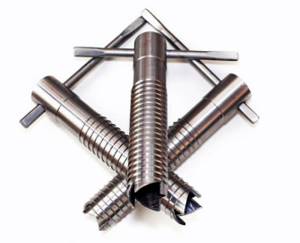
When going fishing in the winter, you need to think about fasteners, since those included in the kit are not particularly durable. It is necessary to make fastenings with threads to securely fasten the tent on the ice. It is installed so that the entrance to it is not on the side from which the wind blows. Before fishing, all zippers are wiped with paraffin so that the locks open well and do not freeze.
It’s a good idea to sew a few reflective elements on top so that cars driving onto the ice at night don’t hit it. Fishing at night requires light and warmth. Some use kerosene lamps with glass or candles, but the best and safest lighting are devices with LED lamps. For warmth, fishermen often use an alcohol candle. In addition, the following devices have gained popularity:
- special gas burners of small sizes;
- burners for tourists;
- blowtorches;
- infrared gasoline or gas heaters, which heat the room very well.
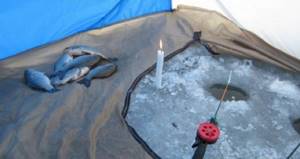
Additionally, you can protect the product from frost using an old tent, making a cover from it, and combining the doors. As a result, the heat lasts several times longer, there is no moisture on the walls, and the temperature reaches 21 degrees. Mini-stoves with solid fuel are also used, which consist of a firebox, a stand under it and a pipe leading outside. You can put both firewood and coal into the firebox.
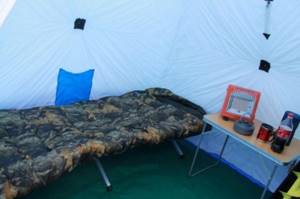
Since these designs are a bit bulky, they are not popular among fishermen. In this case, a gas stove is much more convenient and safer, but it also rarely heats winter tents.
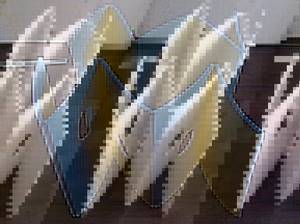
Heat exchanger for a tent for winter fishing
Under normal weather conditions and relatively warm air, additional heating for the tent is not needed. But if you plan to fish at night or the frosts are getting stronger, then you can’t do without heating.
Most often, portable portable burners that run on gasoline or from a small gas cylinder are used for such purposes. In this case, it is additionally advisable to equip a chimney and install a heat exchanger. Heating will take place faster, with minimal fuel consumption for this.
You can use it as a purchased model; the tourism store will offer a good selection, or you can make it yourself. There is nothing complicated about this; you will need skills in soldering pipes or using a welding machine. The set of materials is minimal, but the difference will be felt immediately after the first use.
Criterias of choice
Before choosing a tent for winter fishing, you need to determine:
- dimensions;
- mass;
- type and shape of the structure;
- moisture-resistant characteristics of the awning;
- capacity (1−4 people);
- number of openings (entrance and windows);
- availability of high-quality fastenings (screws, staples, braces);
- degree of frame strength;
- the presence of a hinged canopy for protection from precipitation;
- purpose of the product (for short trips or long trips);
- speed and ease of assembly;
- reliability of materials for the frame (strength, frost resistance);
- the presence of an insulating layer in the protective shelter;
- equipment (mounted shelves, removable pockets for equipment, internal awning);
- price category.
Materials and size
When choosing a tent, the quality of the material for the awning is important, which must withstand sub-zero temperatures and humidity. Manufacturers use nylon, polyester, nylon, lavsan, tarpaulin
The highest quality materials for shelters are lavsan and polyester. These fabrics are resistant to ultraviolet rays and stretching, but are expensive.
Nylon and nylon are less durable budget compounds.
Tarpaulin shelters are light, strong, durable, and provide good ventilation. However, this is a material that does not protect against wet snow during a thaw.
Varieties of fabric according to the type of fiber weaving are represented by the following compositions:
- oxford - used for the bottom, has a dense weave;
- taffeta - material with medium density;
- ripstop is a fabric with the addition of strong threads in weaving.
The marking of the awning indicates the processing of the material. The symbols SI indicate the addition of silicone to the fabric composition, PU - polyurethane. Shelters can have 1-3 layers.
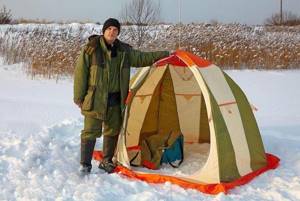
Form and installation method
Protective structures are available in the form:
- cone;
- Cuba;
- hemispheres.
Choosing a winter tent involves determining the installation method:
- auto;
- manual.
The automatic method allows you to quickly install the structure: when you press the control button, the spokes combined with the arches are retracted from the pin in the center of the structure. The frame pipes are connected to the bottom of the tent, which expands when installed. The disadvantage of the products is instability in windy weather.
Products with manual installation require more assembly time and are suitable for stationary fishing. The arcs must be placed in the grooves of the awning and fixed at the corners.
Cube tent installation process
1. Select a flat surface free of foreign objects to install the structure.
2. Remove the tent and accessories from the carrying bag and carefully unfold it.
3. Inspect the folded tent. Make sure that the fabric does not get caught or wrapped around the frame. During installation, be careful not to use excessive force to open the tent, as this may damage the tent.
4. Pull the strap located in the center of one of the walls. Pull until the frame straightens. Thus, it is necessary to install all the walls of the tent.
5. Find the entrance to the tent. Unzip all existing layers. Enter the tent. Using your hands, straighten the roof by lifting it up until the frame is fixed.
6. Secure the tent with tie-down loops on the tent skirt using stakes. For maximum stability, stretch the tent using the lines on the sides. Make sure that the guy lines and tent material are not too tight and can absorb strong winds.
7. Sprinkle the skirt with sand, soil or snow for better protection from drafts.
Due to the specific shape of the roof of the Cuboid 3.60 and Cuboid 4.40 tents, a fastex banner was added to their design at the top of the walls. With its help, you can straighten a small deflection in the middle of the roof, which will prevent the accumulation of precipitation.
In order to install it, you need to fasten the parts of the fastex together and tighten the tape tightly enough so that, due to the tightened walls of the tent, the deflection in the center of the roof rises.

DIY single tent
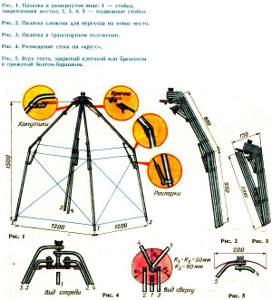
DIY single tent (pattern)
In order to sew a tent, you need to choose lightweight material. I used a thin tarpaulin (whatever I had on hand), but I think a thick cotton fabric would work just fine.
The proposed design has a roof ridge that is not horizontal, like commercially produced samples, but inclined. This is due to the fact that when installing such a tent with its back side facing the wind, its windage will be minimal, and air flows will flow around it.
- When making this type of tent, up to 30% of material is saved, and accordingly, the weight is reduced.
- Such a tent uses only one riser - at the entrance, and the need for a second riser disappears by itself. Instead, a nylon guy is used (from point “a”).
- But the need for a riser may also disappear if there is a tree nearby. In this case, the front guy (from point “fg”) is tied to the tree at the desired height.
- Such a tent can be installed easily and in a short time by one person, which is its big advantage, especially in bad weather.
- As for the riser at the entrance, if it causes some inconvenience, you can use two stands, which are located under the canopy at the entrance in the form of the letter “L”. By arranging the entrance to the tent in this way, you will never get into trouble due to forgetfulness or haste. Such a device for entering the tent will not prevent you from bringing a backpack or spruce branches inside for bedding.
- There is no point in describing the technique of making a tent in detail: everything is very clearly visible from the pattern. I will briefly dwell on just a few points.
- The main guy wire is sewn between points “a – fg” (one continuous nylon cord), additional guys are sewn to points “b” and “c”. Loops for pegs are sewn into the corners of the floor from the outside.
- The loops are all made from the same nylon rope. The doors at the entrance at points “fh - gi” can be equipped with a zipper type fastener.
When the tent is ready, it needs to be given water-repellent properties. This can be done using one of the methods described below.
- The first recipe. Take 4 liters of warm water, dissolve 500 grams of laundry soap in it, add 25 grams of washing soda and 450 grams of rosin powder. Place the tent in the resulting solution and let it lie there for about 15 minutes. Then remove the tent, wring it out and dry it.
- The second recipe. Soak the tent with a 40% warm solution of laundry soap. Then take it out, squeeze it out and put it in a 20% solution of copper sulfate.
After soaking for 15-30 minutes in vitriol, dry the tent. In addition to water-repellent properties, the tent will also acquire a nice green color.
There are other ways to make a tent water-repellent, but they are a little more complicated. Anyone who doesn’t want to bother with such “chemistry” can simply cover the shelter with plastic film, securing it with ordinary clothespins.
DIY winter tent floor
For greater convenience, you can make a floor or flooring in the tent; most often, tourist rugs are used for this, which are glued together. First, round holes are cut into them for a hole according to the diameter of the screw being used.
In addition, aquamats, so-called waterproof bath mats, are used for insulation. But it will not be possible to insulate the floor with their help; the porosity of the material cools quickly and is an excellent conductor.
Some people use penofol and end up with a very slippery surface in the tent, where it won’t take long to get hurt. It is not practical to construct a floor from polystyrene foam; it will take up a lot of space during transportation.
You can experiment with other materials, but as practice has shown, it is best to use travel rugs for the floor.
Top best tents for winter fishing
In the ranking of the best winter tents:
- Tramp Ice Fisher-2;
- Mitek Nelma Cube-2;
- Talberg Shimano-3;
- STACK-UMBRELLA-4;
- Maverick ICE-3 Blue;
- Nova Tour Cube.
Tramp Ice Fisher-2: a cube-shaped tent designed for 2 people. The frame consists of fiberglass pipes, the weight of the product reaches 7 kg. The design is durable, equipped with fastenings in corner areas, and is stable on ice. The shelter is made of dense polyester. The material for the structure impregnated with polyurethane is windproof and moisture resistant. The product is equipped with windows and ventilation valves.
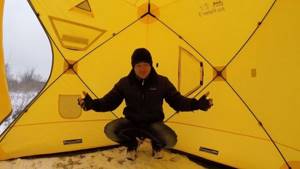
The top best winter protective structures include the Maverick ICE-3 Blue umbrella tent, designed for 3 people. The design is designed for use in northern regions. The frame consists of fiberglass arches with additional fastenings in the corner areas. The awning is made of Oxford polyester, the composition is wind-resistant, waterproof, and durable. The structure unfolds automatically. The dimensions of the product are 2.2x2.55x1.7 m. The shelter has 2 windows, openings for exhaust hood, hanging pockets, reflectors, and nets. Product weight - 5.4 kg.
The Talberg Shimano-3 design is designed for 3 anglers. The frame is made of fiberglass pipes with a diameter of 8.5 mm, supplemented with reinforcing inserts. The shelter is dismantled automatically. The dimensions of the product are 3×2.6×1.75 m. The awning is made of windproof Oxford PU 150D polyester. The kit includes shelves, fasteners, a repair kit and a carrying case.
The STEC-ZONT-4 tent is strong, durable, designed for 4 people. The reliable frame is made of durable titanium alloy, the diameter of the pipes is 8 mm. The dimensions of the model are 3x2.5x1.9 m, weight - 5 kg. The design is stable in windy weather and snowfall.
The protective shelter Mitek Nelma Kub-2 accommodates 2 fishermen. The structure is prefabricated, strong, stable, and consists of duralumin pipes with a diameter of 8 mm. The awning is made of 240T 2000PU polyester with moisture-proof treatment. The model is comfortable to use, safe, and equipped with reflectors attached to the side parts of the structure. There are several ventilation openings. The weight of the product is 8.7 kg. The shelter is equipped with a door made of 2 layers of fabric, additional loops for stretching, and hanging shelves.
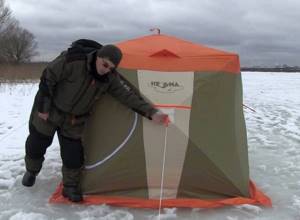
The Nova Tour Cube shelter from the manufacturer Fischerman is designed for 3 people. The dimensions of the model are 1.65 × 2 × 2 m. The design consists of fiberglass pipes with a diameter of 9.5 mm, and strong fastenings are provided in the corners of the frame. The shelter is stable in windy weather and is equipped with ventilation holes. The awning is made of durable, moisture-resistant Oxford 210T 200PU polyester. The design includes windows, pockets, and a protective insert at the bottom. The weight of the product is 7 kg.
Tent in the shape of a hemisphere Nova Tour Nerpa 2 V.2. designed for 2 fishermen. The frame is disassembled automatically; the structure is made of durable fiberglass pipes with a diameter of 8.5 mm. The material is resistant to sub-zero temperatures. The awning is made of waterproof polyester PU2000, complemented by a wide windproof insert. The tent is equipped with pockets, ventilation valves, and guy ropes for stable mounting on ice. The weight of the product is 3.5 kg.
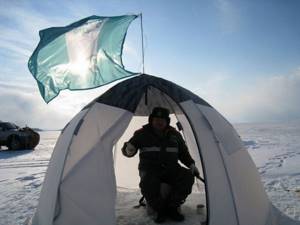
Advantages of a cubic tent
Space
The most important advantage, in our opinion, is the large volume. You will be comfortable staying in a tent with a small group of friends and will still have room for fishing gear, heating equipment and furniture. In terms of comfort, it’s almost like being at home, if you don’t take into account the hole for the hole in the floor. In some models you can even put a folding bed and spend the night on the ice without leaving the holes.
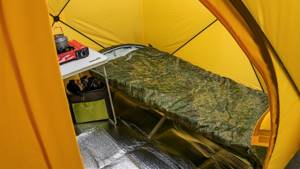
Height
Another undeniable plus is the ability to stand in the tent at full height. The height of the vertical walls of almost all cube models is from 170 to 210 cm. It is very useful and convenient to periodically stretch your legs, rather than sit all day bending over the hole. Your back will thank you. Also, the height of the tent will help you when drilling an additional hole right inside, without removing the tent from the feeding fishing spot.
Quick assembly, intuitive installation and simple design
When the temperature outside is desperately minus and there is strong wind, it is very important to quickly find yourself in a heated tent, protected from the weather. You can easily install the cube with one pair of hands, even if this pair of hands is wearing warm clothing that hinders movement.
Frame rigidity
The “bones” of the cube tent are made of aluminum or fiberglass tubes with a diameter of 9.5 mm, which ensures high frame strength and wind resistance, so you find yourself in the safe arms of a true ice fishing friend.
Heat resistance
The awnings of winter cube tents come in two and three layers, which makes such tents very warm.
Are you ready to run to the checkout again to pay for your purchase? Take your time, let's look at the other side of the coin - the shortcomings of the model.
Types of tents
Tents come in different designs. However, the most common options are:
- In the form of an umbrella. For production, rods or tubes made of duralumin are used. Synthetic fabrics are used as awnings. The finished structure is distinguished by its strength and rigidity.
- With automatic shape change. Such designs are less common. Their peculiarity is that the fabric sewn to the frame can be assembled into a circle.
- Frame of 2-3 arcs. The material of the arcs is fiberglass or duralumin. The frame is assembled directly on the pond, after which an awning is put on it. The tent can be triangular, cube or trapezoid.
How to properly set up a winter tent
Let's look at the features and installation of “umbrellas” and “cubes,” the most popular tents designed for winter fishing. For these purposes, manufacturers produce automatic models to reduce assembly/disassembly time to a minimum. Winter tents are made from waterproof materials that can withstand precipitation and are equipped with pockets for storing things.
Let's start with the "umbrellas". Tents of this type are dome-shaped structures with regular hexagonal shapes.

Photo No. 10: winter umbrella tent
The blowing wind is evenly cut through the body and presses the structure to the ground. Due to the increased streamlining, a ricochet effect is created. Airflow is reduced to a minimum.
"Umbrellas" weigh less than "cubes". The only drawback is that in a small-sized tent, the owner will have to sit close to the center in order to fully straighten his back.
Installation occurs automatically.

Photo No. 11: installation of an umbrella tent
- Straighten the frame using a special mechanism.
- Make sure that the entrance is located on the leeward side.
- Cover the bottom of the tent with snow. This will increase thermal insulation and improve stability.
- Secure storm guy ropes to the ice. Special gimlets with handles or long self-tapping screws are suitable for this.
What should a winter tent be like?
Having decided to independently design a shelter, you need to familiarize yourself with the requirements that it must meet. First of all, the product must protect the fisherman from bad weather. In addition, you need so much space inside to be able to relax, have a snack, and warm up. Today, although you can buy a winter tent, many fishermen prefer to make it with their own hands, taking into account their needs.
A homemade design must meet the following criteria:
- have low weight and dimensions;
- be mobile;
- have a dense and breathable coating;
- easy to install and dismantle;
- retain heat for a long time;
- be strong and strong.

Top 7 best tents
Demand creates supply; there are more than enough ice fishing tents in the retail chain. The rating of the most popular models among fishermen will help you make your choice.
Tramp Ice Fisher 2
The tent has only positive reviews. For its manufacture, fiberglass is used for the frame and windproof polyester for the awning. The size allows two adults to fit inside without interfering with each other at all. A special feature of the model is that the awning is waterproof over the entire area, which is important during sudden changes in temperature, melting snow and precipitation in the form of rain.
Mitek Nelma Cube-2
The tent is designed to accommodate two people at once; among its advantages it is worth noting duralumin rods for the frame and reflective stripes on all sides of the product. Waterproof polyester has fairly high performance, so it is not afraid of rain and melting snow.
Victoria Leshchenko
I've been working hard in the fishing tackle department for the past six years. I can help you assemble almost any gear.
Ask a Question
The disadvantage of the product will be its heavy weight when folded, more than 8 kg.
Fisherman-Nova Tour Cube
The manufacturer claims that this product is designed for three anglers, but in reality only two can fit without restricting movement. The frame is made of fiberglass, the awning is powerful, but not of the best quality, but it can withstand the piercing wind. Water resistance is average, but will protect you from rain. The folded weight is 7 kg, which is good for a three-person tent.
Talberg Shimano 3
The tent of the Chinese manufacturer is in the TOP for a reason; the quality indicators of the product are very good. The frame is made of fiberglass, but it is very strong in terms of stability. For the awning, we used low-ventilation polyester, but it is not waterproof. But don’t be afraid of this, complete getting wet is only possible if the heating element in the tent is working perfectly, and the outside should be completely covered with snow.
Lotus Universal
The tent is designed for three fishermen, they will be comfortable and not cramped inside. The aluminum frame is strong and stable. The awning is made of synthetic fibers with fire-resistant treatment, which will prevent fire both from the inside and outside. The model has two entrances and the same number of windows, which greatly simplifies movement in it. Its light weight and folded dimensions make it indispensable for fishermen without personal transport.
Fisherman-Nova Nour Nerpa 2v.2
The model is an improved version of the original from a well-known manufacturer. The tent is designed for two fishermen, high-quality fiberglass is used for the frame, the awning is made of polyester with windproof characteristics, and is additionally treated with a weak fire-resistant substance.
The product will differ in its elongated skirt and the presence of additional stretch marks, which will be useful in stormy winds. Among other models, weight indicators are also distinguished; the folded tent has a very small size and weighs less than 3 kg.
STACK-UMBRELLA 4
This model is designed to accommodate 4 anglers in the middle. The frame is durable, made of aluminum with titanium, which reduces the weight and thickness of the rods, but is not inferior in endurance. The weight of the product is only 5 kg, this was achieved through the use of a lighter coating. Heavy snowfalls and bitter frosts are not scary for fishermen inside, but it is unlikely that they will be able to wait out heavy rain there.
Victoria Leshchenko
I've been working hard in the fishing tackle department for the past six years. I can help you assemble almost any gear.
Ask a Question
Other products have characteristics that cannot always protect fishermen from bad weather.
Features of the kitchen tent from “Mitek”
- The tent frame is made of steel pipe with a diameter of 25 mm and coated with polymer powder paint. The awning material is Oxford 240 fabric, withstanding 2000 mm of water column.
- A skirt made of thick reinforced fabric is sewn along the entire perimeter of the tent.
- The tent has a large wide entrance, closed with 2 reliable and convenient zippers No. 10.
- 3 walls of the tent are equipped with large windows with mosquito nets. The window shades open fully and are secured with clips to ensure full ventilation of the tent.
- A ventilation valve is provided in the kitchen as a hood, which is located under the roof. It can be fixed in 2 positions using Velcro at the bottom and top of the valve.
- At the bottom of the back wall of the tent there is an adjustable sleeve for supplying electricity or gas.
- The tent is equipped with 4 reliable guy loops at the corners.
